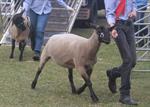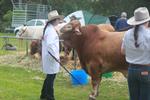Managing Livestock
Choosing What Animals To Farm
It is important to select the right animal and number of head for the land size available.
Stages Of The Life Cycle
Some farmers breed and rear young animals, whilst some buy young animals and grow them on. Other farmers grow animals for a particular product, or keep the same type of animal for different products (e.g. cattle may be grown for veal, for beef or for dairy).
Select the stage of development you wish to produce on your farm.
Methods to Care for Animals
 This can involve such things as feeding, watering, grooming, control of pests or diseases, breeding and rearing young, providing shelter, managing periodical grazing.
This can involve such things as feeding, watering, grooming, control of pests or diseases, breeding and rearing young, providing shelter, managing periodical grazing.
Identification of resources, both natural and man-made, will have a great effect on determining the method of care.
To sustain livestock production on a property, the following must be done:
- Choose breeds that are appropriate to the location.
- Do not over stock a property.
- Use a production system that is appropriate for the breed and location.
- Follow land care practices that do not damage the property (e.g. erosion control appropriate to soil type).
Selecting a Breed
Know the type and quantity of feed and water available before choosing a breed of livestock. Discuss any proposed selection with local people who know the area. Consider the way in which the livestock might need to be managed (e.g. fencing requirements, frequency of moving animals). You need to have the manpower, equipment and financial resources to manage the chosen breed in a sustainable way. If you don't have adequate resources, you might be better to choose a different type of animal (e.g. goats are good in a paddock for a while to eradicate weeds, but at a certain point, they can start to cause degradation of land).
Stocking Rates
This refers to the number of animals that can be supported by a specified area (i.e. head per hectare). The optimum stocking rate of a property may vary from month to month and year to year, according to seasonal changes and unproductive periods such as drought.
Supplementary feeding and watering may allow stocking rates to be increased on a property, or at least maintained during periods of poor pasture growth. Animals may also be put elsewhere under agistment (the temporary reallocation of stock to another location), to relieve their influence on the property.
Problems can develop if animals are allowed total freedom on a property. For example, they may congregate in one particular area, causing erosion, or they might only eat one particular pasture species, causing a change in the pasture composition. Generally, animals are restricted to different areas at different times.
Fencing
Fencing is necessary to contain stock, but it can also injure stock. Fencing is traditionally six strands of barbed wire; however, most vets oppose using barbed wire because it injures stock, affects their health, and damages hides (making them less valuable for the hide industry). One or two strands of barbed wire will generally be adequate, with the remaining strands being plain wire.
The best fence is post and rail (four rails for small animals or two to three for large animals). In most instances, post and rail fencing is too expensive to be economically viable, except for intensive areas such as stock yards or feed lots. Post and rail may also be used to contain particularly strong or valuable animals, such as stud horses or bulls.
Electric fences are relatively inexpensive and increasingly popular. They can be moved with relative ease, providing much greater flexibility and allowing paddocks to be reconfigured frequently. Electric fences can, however, be a fire risk if the fence lines are not routinely checked.
All types of fencing require maintenance. Fences do move and need straightening, gates deteriorate and need to be repaired. Electric fences perhaps take less effort to maintain them than others.
Working as a Livestock Farmer
 Farms are generally arable (crops), dairy or livestock, and are run by management companies or single-owner farmers. Most livestock farm would specialise, for example, in dairy cattle, beef cattle and or sheep. Alternatively, they may have pigs or poultry. Mixed farms are less common.
Farms are generally arable (crops), dairy or livestock, and are run by management companies or single-owner farmers. Most livestock farm would specialise, for example, in dairy cattle, beef cattle and or sheep. Alternatively, they may have pigs or poultry. Mixed farms are less common.
Livestock farmers raise animals, organise farm administration, work machinery, organise associated businesses and manage staff. They need to have technical and practical competence, as well as the ability to make sound business decisions.
Starting Out
Livestock farming can be a difficult occupation to get in to unless your family owns a farm, or you have the money to buy a farm. It is certainly possible to become a farmer though, without having these things to give you a head start if you have the determination.
Some people get a start through study, followed up by experience. Others start with experience, and perhaps do some studies later on.
A good way to get experience is as a farm hand or stock man.
Some people get started as a farm contractor, driving machinery.
Some become share farmers.
There are lots of different ways to get a start.
ACS offer a great range of Agriculture courses, and these can all be studied whilst you are working. These cover a complete range of subject areas including livestock husbandry, pasture management, animal health care, breeding, farm management and much more. Many of our qualifications give you options to specialise in areas of interest to you, meaning you acquire the knowledge you need with a qualification unique to you.
Talk to us today - phone us on (UK) 01384 442752 or (International) +44 (0) 1384 442752, or submit questions to our specialist Agriculture tutors - tell them your goals and which courses you are thinking of studying with us.
[27/12/2025 06:47:13]